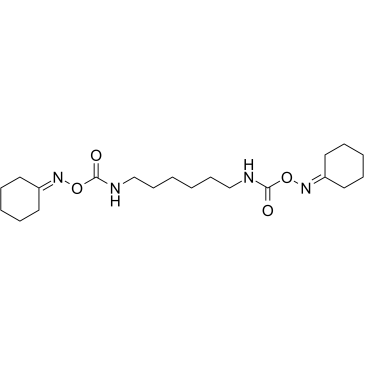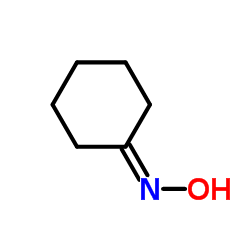RHC-80267

RHC-80267 structure
|
Common Name | RHC-80267 | ||
|---|---|---|---|---|
| CAS Number | 83654-05-1 | Molecular Weight | 394.508 | |
| Density | 1.2±0.1 g/cm3 | Boiling Point | N/A | |
| Molecular Formula | C20H34N4O4 | Melting Point | N/A | |
| MSDS | USA | Flash Point | N/A | |
Use of RHC-80267RHC 80267 (U-57908) is a potent and selective inhibitor of diacylglycerol lipase (DAGL) (with IC50 of 4 μM in canine platelets). RHC-80267 inhibits cholinesterase activity with an IC50 of 4 μM, thereby enhancing the relaxation evoked by acetylcholine. RHC 80267 also inhibits COX and the hydrolysis of phosphatidylcholine (PC)[1][2][3][4]. |
| Name | (cyclohexylideneamino) N-[6-[(cyclohexylideneamino)oxycarbonylamino]hexyl]carbamate |
|---|---|
| Synonym | More Synonyms |
| Description | RHC 80267 (U-57908) is a potent and selective inhibitor of diacylglycerol lipase (DAGL) (with IC50 of 4 μM in canine platelets). RHC-80267 inhibits cholinesterase activity with an IC50 of 4 μM, thereby enhancing the relaxation evoked by acetylcholine. RHC 80267 also inhibits COX and the hydrolysis of phosphatidylcholine (PC)[1][2][3][4]. |
|---|---|
| Related Catalog | |
| Target |
IC50: 4 μM (Canine diacylglycerol lipase), 4 μM (Cholinesterase); COX; Phosphatidylcholine[1][3][4] |
| In Vitro | The potentiation by RHC 80267 of the relaxation to acetylcholine could be caused by the inhibition of cholinesterase: (1) RHC 80267 does not affect the responses to carbachol, the carbamyl derivative of acetylcholine which only differs from acetylcholine by its resistance to hydrolysis by cholinesterase, and (2) the effect of RHC 80267 is mimicked by the inhibitor of cholinesterase neostigmine, RHC 80267 showing no additional effect in the presence of a maximally effective concentration of neostigmine. The determination of the effect of RHC 80267 on the cholinesterase activity of brain homogenate confirmed that RHC 80267 inhibits this enzyme in the same range of concentrations increasing the relaxation to acetylcholine, namely at 1-10 μM[2]. |
| In Vivo | RHC 80267 (40 μM) enhances contractions induced by U46619 (a thromboxane A2 analog) in human and rat pulmonary arteries (hPAs and rPAs, respectively) and by angiotensin II (ANG II) in rPAs in an endothelium-dependent manner[3]. |
| References |
| Density | 1.2±0.1 g/cm3 |
|---|---|
| Molecular Formula | C20H34N4O4 |
| Molecular Weight | 394.508 |
| Exact Mass | 394.257996 |
| PSA | 101.38000 |
| LogP | 3.12 |
| Index of Refraction | 1.571 |
|
Section1. IDENTIFICATION OF THE SUBSTANCE/MIXTURE Product identifiers Product name: RHC 80267 CAS-No.: 83654-05-1 Section2. HAZARDS IDENTIFICATION
Classification of the substance or mixture
Not a hazardous substance or mixture according to Regulation (EC) No. 1272/2008. This substance is not classified as dangerous according to Directive 67/548/EEC. Label elements The product does not need to be labelled in accordance with EC directives or respective national laws. Other hazards - none Section3. COMPOSITION/INFORMATION ON INGREDIENTS Substances Synonyms: 1,6-bis(Cyclohexyloximinocarbonylamino)hexane Formula: C20H34N4O4 Molecular Weight: 394,51 g/mol Section4. FIRST AID MEASURES Description of first aid measures If inhaled If breathed in, move person into fresh air. If not breathing, give artificial respiration. In case of skin contact Wash off with soap and plenty of water. In case of eye contact Flush eyes with water as a precaution. If swallowed Never give anything by mouth to an unconscious person. Rinse mouth with water. Most important symptoms and effects, both acute and delayed To the best of our knowledge, the chemical, physical, and toxicological properties have not been thoroughly investigated. Indication of any immediate medical attention and special treatment needed no data available Section5. FIREFIGHTING MEASURES Extinguishing media Suitable extinguishing media Use water spray, alcohol-resistant foam, dry chemical or carbon dioxide. Special hazards arising from the substance or mixture Carbon oxides, nitrogen oxides (NOx) Advice for firefighters Wear self contained breathing apparatus for fire fighting if necessary. Further information no data available Section6. ACCIDENTAL RELEASE MEASURES Personal precautions, protective equipment and emergency procedures Avoid dust formation. Avoid breathing vapors, mist or gas. Environmental precautions Do not let product enter drains. Methods and materials for containment and cleaning up Sweep up and shovel. Keep in suitable, closed containers for disposal. Reference to other sections For disposal see section 13. Section7. HANDLING AND STORAGE Precautions for safe handling Provide appropriate exhaust ventilation at places where dust is formed.Normal measures for preventive fire protection. Conditions for safe storage, including any incompatibilities Store in cool place. Keep container tightly closed in a dry and well-ventilated place. Specific end uses no data available Section8. EXPOSURE CONTROLS/PERSONAL PROTECTION Control parameters Components with workplace control parameters Exposure controls Appropriate engineering controls General industrial hygiene practice. Personal protective equipment Eye/face protection Use equipment for eye protection tested and approved under appropriate government standards such as NIOSH (US) or EN 166(EU). Skin protection Handle with gloves. Gloves must be inspected prior to use. Use proper glove removal technique (without touching glove's outer surface) to avoid skin contact with this product. Dispose of contaminated gloves after use in accordance with applicable laws and good laboratory practices. Wash and dry hands. The selected protective gloves have to satisfy the specifications of EU Directive 89/686/EEC and the standard EN 374 derived from it. Body Protection Choose body protection in relation to its type, to the concentration and amount of dangerous substances, and to the specific work-place., The type of protective equipment must be selected according to the concentration and amount of the dangerous substance at the specific workplace. Respiratory protection Respiratory protection is not required. Where protection from nuisance levels of dusts are desired, use type N95 (US) or type P1 (EN 143) dust masks. Use respirators and components tested and approved under appropriate government standards such as NIOSH (US) or CEN (EU). Section9. PHYSICAL AND CHEMICAL PROPERTIES Information on basic physical and chemical properties a) AppearanceForm: solid Colour: off-white b) Odourno data available c) Odour Thresholdno data available d) pHno data available e) Melting point/freezingno data available point f) Initial boiling point and no data available boiling range g) Flash pointno data available h) Evaporation rateno data available i) Flammability (solid, gas) no data available j) Upper/lowerno data available flammability or explosive limits k) Vapour pressureno data available l) Vapour densityno data available m) Relative densityno data available n) Water solubilityno data available o) Partition coefficient: n- no data available octanol/water p) Autoignitionno data available temperature q) Decompositionno data available temperature r) Viscosityno data available s) Explosive propertiesno data available t) Oxidizing propertiesno data available Other safety information no data available Section10. STABILITY AND REACTIVITY Reactivity no data available Chemical stability no data available Possibility of hazardous reactions no data available Conditions to avoid no data available Incompatible materials Strong oxidizing agents Hazardous decomposition products Other decomposition products - no data available Section11. TOXICOLOGICAL INFORMATION Information on toxicological effects Acute toxicity no data available Skin corrosion/irritation no data available Serious eye damage/eye irritation no data available Respiratory or skin sensitization no data available Germ cell mutagenicity no data available Carcinogenicity IARC:No component of this product present at levels greater than or equal to 0.1% is identified as probable, possible or confirmed human carcinogen by IARC. Reproductive toxicity no data available Specific target organ toxicity - single exposure no data available Specific target organ toxicity - repeated exposure no data available Aspiration hazard no data available Potential health effects Inhalation May be harmful if inhaled. May cause respiratory tract irritation. IngestionMay be harmful if swallowed. SkinMay be harmful if absorbed through skin. May cause skin irritation. EyesMay cause eye irritation. Signs and Symptoms of Exposure To the best of our knowledge, the chemical, physical, and toxicological properties have not been thoroughly investigated. Additional Information RTECS: Not available Section12. ECOLOGICAL INFORMATION Toxicity no data available Persistence and degradability no data available Bioaccumulative potential no data available Mobility in soil no data available Results of PBT and vPvB assessment no data available Other adverse effects no data available Section13. DISPOSAL CONSIDERATIONS Waste treatment methods Product Offer surplus and non-recyclable solutions to a licensed disposal company. Contaminated packaging Dispose of as unused product. Section14. TRANSPORT INFORMATION UN number ADR/RID: -IMDG: -IATA: - UN proper shipping name ADR/RID: Not dangerous goods IMDG: Not dangerous goods IATA:Not dangerous goods Transport hazard class(es) ADR/RID: -IMDG: -IATA: - Packaging group ADR/RID: -IMDG: -IATA: - Environmental hazards ADR/RID: noIMDG Marine pollutant: noIATA: no Special precautions for user no data available Section15. REGULATORY INFORMATION This safety datasheet complies with the requirements of Regulation (EC) No. 1907/2006. Safety, health and environmental regulations/legislation specific for the substance or mixture no data available Chemical Safety Assessment and is applicable to the product with regard to appropriate safety precautions. It does not represent any SECTION 16 - ADDITIONAL INFORMATION N/A |
|
~% 
RHC-80267 CAS#:83654-05-1 |
| Literature: Petersen Justus Liebigs Annalen der Chemie, 1949 , vol. 562, p. 210,220 |
| Precursor 2 | |
|---|---|
| DownStream 0 | |
|
Capsazepine, a vanilloid antagonist, abolishes tonic responses induced by 20-HETE on guinea pig airway smooth muscle.
Am. J. Physiol. Lung Cell. Mol. Physiol. 288(3) , L460-70, (2005) The aim of this study was to delineate the mode of action of 20-hydroxy-eicosatetraenoic acid (20-HETE) in airway smooth muscle (ASM) cells. ASM metabolizes arachidonic acid by various enzymatic pathw... |
|
|
L- and N-current but not M-current inhibition by M1 muscarinic receptors requires DAG lipase activity.
J. Cell Physiol. 216(1) , 91-100, (2008) Stimulation of postsynaptic M(1) muscarinic receptors (M(1)Rs) increases firing rates of both sympathetic and central neurons that underlie increases in vasomotor tone, heart rate, and cognitive memor... |
|
|
Brain phospholipase C-diacylglycerol lipase pathway is involved in vasopressin-induced release of noradrenaline and adrenaline from adrenal medulla in rats.
Eur. J. Pharmacol. 499(1-2) , 99-105, (2004) Recently, we reported that intracerebroventricularly (i.c.v.) administered arginine-vasopressin evokes the release of noradrenaline and adrenaline from adrenal medulla by brain thromboxane A2-mediated... |
| 1,6-Bis-cyclohexylidenaminooxycarbonylamino-hexan |
| (Hexane-1,6-diyldiimino)bis{[(cyclohexylideneamino)oxy]methanone} |
| Cyclohexanone, O,O'-[1,6-hexanediylbis(iminocarbonyl)]oxime |
| (1,6-Hexanediyldiimino)bis{[(cyclohexylideneamino)oxy]methanone} |
| 1,6-bis-cyclohexylidenaminooxycarbonylamino-hexane |

